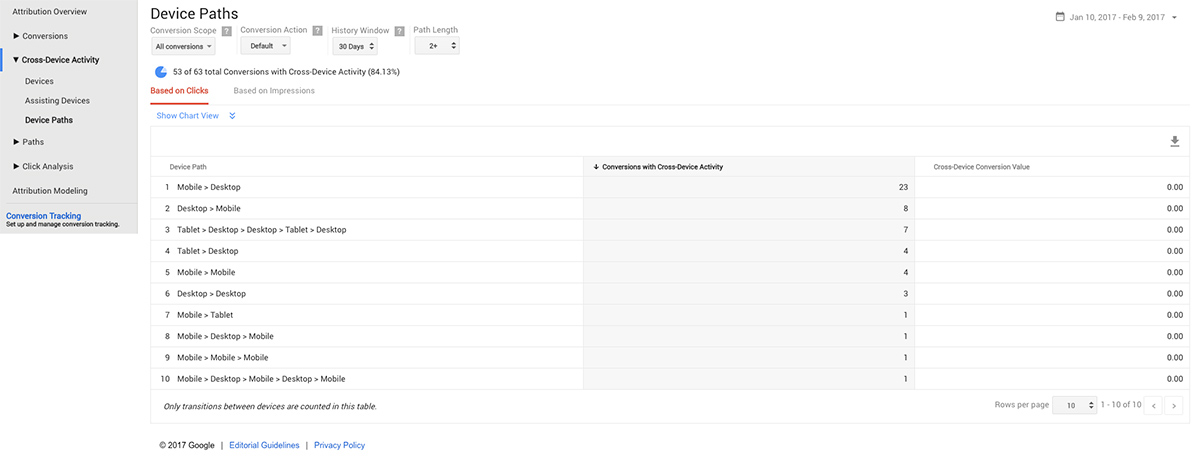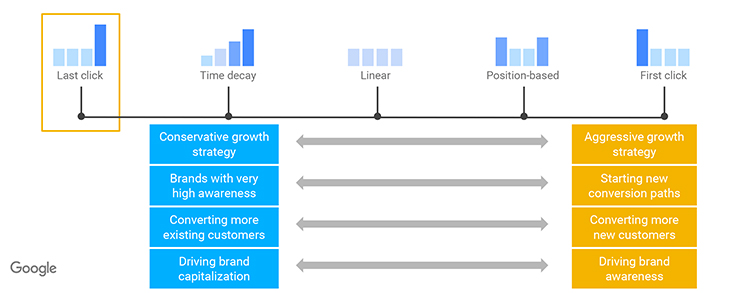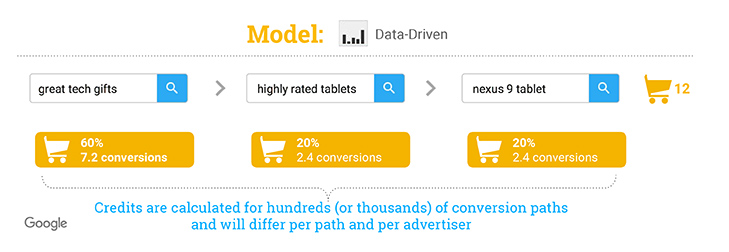This is an archived article and contains information that has not been updated or reviewed since it was originally published. For more information regarding the content in this article, please contact us.
AdWords Tools for Cross Device Measurement
Google is in a unique position to tackle the issue of cross-device conversion tracking. Because the Google ecosystem includes so many different properties (Chrome, Gmail, YouTube, Maps, Apps etc.), that each have over a billion users, they have a gigantic data set on which to analyze the behaviour of signed-in users across multiple devices. Google claims to have 100% accuracy of synced users across devices. They use this information to extrapolate the online behaviour of users who are not signed in (claiming an impressive statistical significance of 95%), and attribute advertising spend across the entire customer journey.
What is Attribution Modelling?
Attribution modelling allows you to decide (based on data) how much credit each ad click should get for a conversion. You can use attribution modelling to find new opportunities to influence customers earlier in the sales cycle and optimize your bidding strategies to improve ad performance.
The default setting in AdWords is “last click” attribution. In this model, all credit is given to the final click in the conversion path. However, depending on the goals of your advertising campaigns, last-click attribution may not be the most appropriate. For example, if branding is your primary goal, a first-click attribution model may be a more appropriate measure of your ad spend.
Attribution Modelling Tools
AdWords offers a variety of tools that help you understand your customers’ paths to conversion, and assess ROI on digital advertising investments. The attribution tool is available to all standard AdWords accounts (under the “Tools” menu in the main dashboard). In this tool, you can view a variety of conversion metrics and Cross-Device Activity reports.
If you are just getting started with Attribution, you will want to look at your “Device Paths” report (see below). This report will show you the various touchpoints on your marketing campaigns that are involved in a conversion. As you can see in the example below, in most cases people are using multiple devices before making a purchase, and that journey often begins on a mobile device. We can use this information to better target our ads and landing pages to mobile users who are beginning the purchase process.

Other interesting reports in this tool include the “top path” report, “time lag” report and the “path length” report. Please note these reports are also available in Google Analytics, where they will also include data from other marketing channels (organic, social, referral traffic, etc.). These path reports can give you a good idea about the length and variety of digital “micromoments” that are involved in your own customers’ path to purchase.
Before you change your attribution model consider the following:
- What are you measuring (purchases, engagement, phone calls)?
- Why are you measuring (allocate marking budgets, access performance etc.)?
- What part of the sales funnel does your advertising target?
- How long is your customer journey (what should the look-back window be set at)?
- What devices are used in your customer journey (look at non-converting customers too)?
When you have a clear understanding of your customer path, you can use click analysis reports to experiment with modifying your conversion attribution in AdWords.
More on Attribution Models
“Anything is better than last click, but it depends on your business model”

Once you have a firm understanding of the questions above, decide if changing your attribution model is appropriate for your business goals. AdWords offers the following attribution models:
1. Last-Click
Default setting that gives credit to the last click in the conversion path
2. First Click
Gives credit to the first click in the conversion path
3. Linear
Distributes credit evenly across all clicks in the conversion path
4. Time Decay
Gives the most credit to clicks that happened closer to the time of conversion
5. Position Based
Gives 40% credit to both the last and first clicks and spreads out the remaining 20% over other clicks
6. Data Driven
This is the most accurate of all attribution models and is based directly on your own data. To use the data-driven model your account requires >800 conversions and >80 000 clicks.

What all this means
Once you have selected your attribution model, you can use it to better evaluate the success of your AdWords campaigns and to inform your future optimization and bidding decisions.
Here are the main takeaways:
- The setup is pretty easy, “flip the switch”
- Look at your data before you choose a model
- Choose a model for each of your conversion types
- Use the information to adjust your bidding strategies
If I lost you way back at the beginning somewhere, that’s okay. Contact Us at Ontario SEO, we can audit your AdWords accounts for you and help you make your attribution decisions.



